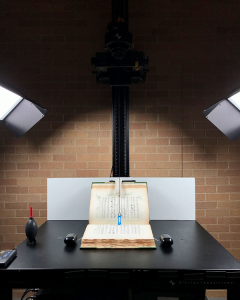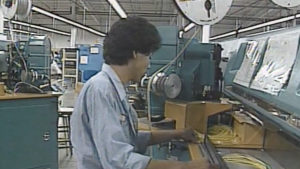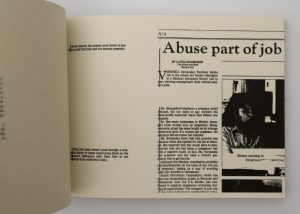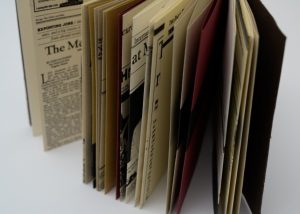Introduction
Willis Library provides many materials and services, which patrons and students may be surprised to learn exist. I am the GSA in the Digital Projects Unit of Willis Library, and I digitize primary materials for institutional partners to contribute to the Portal to Texas History. I have worked on projects like the CC Cox Collection, the National WASP WWII Museum Collection the Maude Kitchen Tintypes, and many more. I also digitize books, photographs and other objects for the UNT Digital Library! This kind of work requires much in terms of time, technology and know-how. As a graduate student in the College of Visual Art and Design (CVAD), I am on my way to earning an MFA in Photography. The Digital Projects Unit was in search for a GSA that had technical experience in photography, and began a relationship with the Photography Department in CVAD. As an MFA student in Photography, I originally set out to only focus on the artistic expression of making photographs. When I discovered an opportunity to work for the Digital Projects Unit here in Willis Library I jumped at the chance to work here. I have been here for the past two years, digitizing materials primarily using the Phase One system—a tethered capture camera system used by many institutions to digitize cultural heritage materials.
Photo and Digitization
In digitization, we aim to preserve materials in a digital format so that the item, through proxy of the computer screen, will be available to a worldwide audience for the foreseeable future. “Digitization is the conversion of any type of original, be it paper, photographic prints or slides, three dimensional objects or moving images into a digital format.” (Astle & Muir, 2002. p. 67). This digital format can exist in a variety of formats that many of us with some computer proficiency may recognize, such as .TIFF and .JPEG. There is much information in Library Science scholarship which examines access and preservation goals that digitization can solve, as well as some of the challenges that can arise from this method of preserving cultural heritage. My main experience in this field has been through photography, using it as a tool to digitize cultural heritage materials.

Copy stand with Phase One/DT Photon system in the Digital Projects Unit. Photo by the author

Video clip KXAS-TV screenshot, licensed under University of North Texas Libraries, The Portal to Texas History
Artists Using Primary Sources
There is an incredible amount of overlap for artists, like myself, who seek primary sources for research, and for the purpose of artmaking. Students in art can take advantage of what the Portal to Texas History and the UNT digital library have to offer. As an artist, there are many possibilities for using the Portal to Texas History for source materials such as news articles, photographs, and other primary sources. I have used video clips themselves from the Portal in my own work, as primary source research, as well as speaking to the ideas I want to communicate. This is an important aspect to creating research-based art today. Also, I have used other databases like the Newspaper Archive to create a stab bound book pertaining to my research. To take advantage of these databases that provide primary sources to make artwork is both relevant to history and the current day.

Artist Book Part 1. Photo by the author

Artist Book Part 2. Photo by the author
Astle, P. J., & Muir, A. (2002). Digitization and preservation in public libraries and archives. Journal of Librarianship and Information Science, 34 (2), 67–79. Retrieved from https://doi.org/10.1177/096100060203400202
KXAS-TV (Producer). (1988, August 14). News Clip: Mexico Dr. [Video file]. University of North Texas Libraries, The Portal to Texas History, https://texashistory.unt.edu. Retrieved from https://texashistory.unt.edu/ark:/67531/metadc858221



Leave a Reply